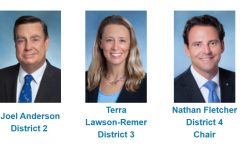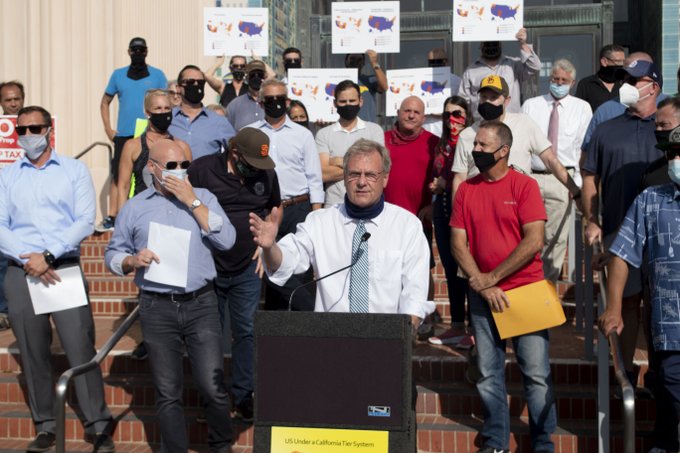
Cal. Attorney General Xavier Becerra. (Photo: Kevin Sanders for California Globe)
AG Becerra Intervenes In San Diego County Housing Development Case Over Wildfire Concerns
Otay Ranch case becomes second state wildfire development case intervention this year
By Evan Symon, March 18, 2021 7:43 pm
On Wednesday, outgoing California Attorney General Xavier Becerra filed motions in the lawsuits over San Diego County’s approval over the 36 square mile Otay Ranch development site.
The Otay Ranch development, which would add over 3,000 single family residential units, as well as commercial spaces, parks, resort areas, and civic buildings such as fire stations, has drawn controversy over being in a high wildfire risk area. Since the beginning of the century, multiple wildfires have erupted in and around the site, including the 2007 Harris Fire that burned over 90,000 acres.
Due to the high wildfire risk and San Diego County’s quick approval of the Otay Ranch projects plan, Becerra backed the lawsuit by noting that the environmental impact reports (EIRs) approved by the County don’t adequately cover what the wildfire risk would actually be in a newly developed area with thousands of people. Becerra specifically cites 2018 updates to the California Environmental Quality Act (CEQA), with the County’s failure to mitigate and address higher risks being in violation of the Act.
“On the heels of another dry winter, Californians are looking toward wildfire season with a familiar pit of dread in their stomachs,” said Attorney General Becerra on Wednesday. “Devastating wildfires have become the norm in recent years, with dozens of deaths and whole towns forced to evacuate. That’s why local governments must address the wildfire risks associated with new developments at the front end. It is imperative for public safety – and required by the law. Today’s action aims to ensure that the County of San Diego does all it can to mitigate the risks of the Otay Ranch projects before they are built.”
Becerra’s San Diego action comes only a month after joining a similar increased wildfire risk court challenge over the 25 square mile Guenoc Valley Ranch property in Lake County in Northern California. Becerra’s intervention last month was the first time that a state had joined in a court action to argue wildfire prevention over new housing.
Developers, state, environmentalists at odds over Otay site
Developers have viewed Becerra’s actions as overstepping of the state’s authority, particularly when it comes to safety and development laws.
“We think Becerra is stepping over the line, primarily because you can’t build in these areas without putting together a very sophisticated plan fully approved by the local fire chief, fully approved by all the fire officials,” California Building Industry Association CEO Dan Dunmoyer said in a statement on Wednesday. “We are building parks, we’re building entire infrastructure systems that don’t burn and can protect these communities from fires.
“California is a gorgeous state, but it has mudslides, it has fire, it has flooding, it has earthquakes. You plan accordingly. And you mitigate it, you protect it, you use tough codes, and that’s what we’ve done.”
Dunmover also noted that rebuilding in urban areas is often much more difficult due to local opposition and higher costs compared to more rural areas.
However, environmental experts noted that Becerra, as well as groups such as the Center for Biological Diversity that originally filed the suits, have valid points and concerns.
“What Becerra just did was essentially make sure that the state isn’t trying to solve the housing crisis by building new homes in areas that would be burnt down within 10 years due to a wildfire,” said environmental lawyer and consultant Dave Gries to the Globe. “They’re also making sure that these large areas they are about to build on won’t disrupt the environment, like many groups are arguing. We’re talking about dozens of square miles.
“I know developers say it’s harder to build in already built up areas, but you know, it’s a lot safer and you have access to more infrastructure.
“But, legally speaking, there is bases for what Becerra is doing, and his successor will have heir hands full with the San Diego and Lake cases they just entered. As someone who has taken on developers before over areas only a couple of acres big, I can’t tell you how much they’ll fight over a development that stretches on for dozens of square miles.”
The motions filed in the Lake and San Diego cases are expected to continue on through the next state Attorney General following Becerra’s confirmation as the next Health and Human Services Secretary on Thursday in Washington.
- Bill to Require Law Enforcement Disclosure if AI Was Used To Help Write Reports - August 7, 2025
- Gov. Newsom Files FOIA Request To ‘Expose True Cost’ Of L.A. Federal Troop Deployment for Anti-ICE Riots - August 6, 2025
- California Redistricting: How Newsom’s Plan Will Demolish Hard Fought GOP Gains - August 6, 2025





The pressure to build suburban sprawl housing in Otay Ranch and elsewhere is due to the unwillingness of government officials from Washington D.C. to Sacramento, to San Diego County, and to as many as 14 other California counties, and to responsible local city officials throughout the state, to abide with the law enacted by approval by 74% of eligible voters in November 2008 of Proposition 1A. This measure calls for construction of 24 new and largely auto-free, high-density megacities connected by an 800-mile high-speed train system and connecting local transit services. The State’s two prior Attorneys General should have done something about this long ago before they skipped town for higher office in Washington, D.C. But at least the process has begun to deal with the issue head-on. A viable solution has been presented, but no one seems to consider it seriously.